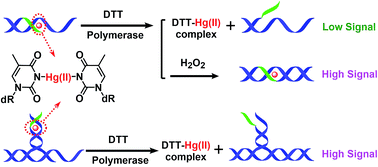Fidelity quantification of mercury(ii) ion via circumventing biothiols-induced sequestration in enzymatic amplification system†
Abstract
Mercury(II) ion (Hg2+) is a hazardous pollutant with distinct toxicological profiles that can cause deleterious effects on human health and the environment even at low concentrations, so an accurate detection method with high sensitivity is of great importance. Compared with traditional techniques requiring sophisticated instrumentation and skilled personnel, Hg2+ sensors based on nucleic acids amplification outperform others due to their efficiency, robustness, and ease of operation. Among these nucleic acids amplification-based strategies, a common problem meriting attention is that biothiols such as dithiothreitol (DTT) extensively exist in enzymatic amplification systems as essential components to guarantee tool enzyme activity. However, due to the high affinity of Hg2+ and S-donor atoms, biothiols tend to sequestrate Hg2+ and are probably present to affect the accuracy of detection. Herein, a fidelity quantification of Hg2+ based on nucleic acids amplification is developed via a redox reaction or DNA architecture probe. Upon circumventing a biothiols-induced sequestration in enzymatic amplification system, the proposed strategy exhibits excellent accuracy and sensitivity with a detection limit down to 300 pM.


 Please wait while we load your content...
Please wait while we load your content...